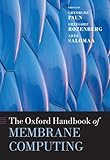The Oxford Handbook of Membrane Computing / edited by Gheorghe Paun, Grzegorz Rozenberg & Arto Salomaa.
Material type: TextLanguage: English Publication details: Oxford ; New York : Oxford University Press, 2010.Description: xviii, 672 p. : ill. ; 26 cmISBN:
TextLanguage: English Publication details: Oxford ; New York : Oxford University Press, 2010.Description: xviii, 672 p. : ill. ; 26 cmISBN: - 9780199556670 (hardback)
- Membrane computing
- 621.391 22 PAU
| Item type | Current library | Collection | Call number | Status | Date due | Barcode |
|---|---|---|---|---|---|---|
 Reference Books
Reference Books
|
CUTN Central Library Reference | Non-fiction | 621.391 PAU (Browse shelf(Opens below)) | Not for loan | 43442 |
1. An introduction to and an overview of membrane computing 2. Cell biology for membrane computing 3. Computability elements for membrane computing 4. Catalytic P systems 5. Communication P systems 6. P Automata 7. P systems with string objects 8. Splicing P systems 9. Tissue and population P systems 10. Conformon P systems 11. Active membranes 12. Complexity -- Membrane division, membrane creation; 13. Spiking neural P systems 14. P systems with objects on membranes 15. Petri nets and membrane computing 16. Semantics of P systems 17. Software for P systems 18. Probabilistic/stochastic models 19. Fundamentals of metabolic P systems 20. Metabolic P dynamics 21. Membrane algorithms 22. Membrane computing and computer science 23. Other developments
'Part of the broader research field of natural computing, Membrane Computing is an area within computing science that aims to abstract computing ideas and models from the structure and functioning of living cells, as well as from the way the cells are organized in tissues or higher orderstructures. It studies models of computation (known as P systems) inspired by the biochemistry of cells, in particular by the role of membranes in the compartmentalization of living cells into "protected reactors". This handbook provides both a comprehensive survey of available knowledge and established research topics, and a guide to recent developments in the field, covering the subject from theory to applications. The handbook is suitable both for introducing novices to this area of research, and as a mainsource of reference for active researchers. It sets out the necessary biological and formal background, with the introductory chapter serving as a gentle introduction to and overview of membrane computing. Individual chapters, written by leading researchers in membrane computing, present the stateof the art of all main research trends and include extensive bibliographies.'--From books.google.com.hk.
Includes bibliographical references and index.


There are no comments on this title.